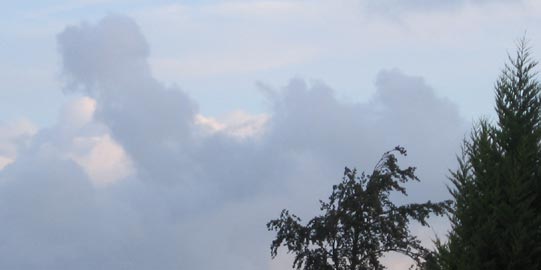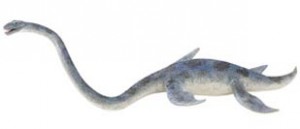Hunting Nessie in the Clouds
Loch Ness Monster Sighting up in the Air
Another early morning for team members at Everything Dinosaur. One of our staff had a very early start, going off for a series of meetings to help plan for 2010 and such like. However, not wanting this person to feel lonely in the warehouse when they clocked in this morning, I was there to make the tea and check what we needed to get done today.
My intention was to finish the review of the new Bullyland Pachycephalosaurus model that has just been introduced. We are writing an article for an ezine website and I wanted to complete this today so that I would not have to worry about it over the weekend.
To view the extensive range of Bullyland dinosaur and prehistoric animal figures: Bullyland Dinosaur and Prehistoric Animal Models.
However, whilst outside the front of the warehouse, in the early morning light we noticed a strange and bizarre looking cloud formation in the sky. The wind was quite strong, and the cloud was breaking up as it sped on by but we remarked how it resembled the classic image of the Loch Ness Monster. Nessie, as rumour has it is believed to be a large, hump-backed creature, a resident of that famous Scottish loch. Many sightings, photographs and even moving images of strange goings on at Loch Ness have been taken over the years and some observers think they saw a marine reptile, a plesiosaur.
Spotting Nessie in the Clouds

Picture credit: Everything Dinosaur
Hunting Nessie
Our picture shows a strange cloud formation, a head facing to the left followed by two distinct humps, a sort of camel shaped cloud in the sky. This formation reminded us of the pictures and illustrations of Nessie the famous Loch Ness Monster. We are very sceptical regarding the existence of a large animal unknown to science living in such a body of water, however, there are a number of large lakes around the world associated with monsters and other stories. Much as we would love someone to discover a plesiosaur or indeed any type of marine reptile (pliosaur, mosasaur, ichthyosaur we really are not fussy), it is highly unlikely there is a Mesozoic monster swimming around Loch Ness.
However, we can dream and the discovery of the Coelacanth plus the Megamouth shark are examples of some of the surprises Mother Nature can come up with. One of the explanations given by scientists for people mistaking upturned boats, or logs floating in the water for prehistoric monsters is that with all the images and drawings of Nessie that have been seen, people “superimpose” the animal’s image onto everyday objects seen at unusual angles or at distance on the water. If observers are aware that the Loch Ness Monster has a long neck and humps along its body, then this is what they conveniently see when looking at strange objects. This phenomenon has been tested on numerous occasions, I remember reading a report about a bus load of tourists who were visiting Loch Ness and subjected to a trick, whereby at a given signal a plank of wood was raised from the lake bed and quickly sunk again. The surprised tourists were then asked to draw and describe what they saw. This inanimate object, a bare piece of timber suddenly sprouted humps and had a pair of eyes, plus a definite mouth as described by the puzzled onlookers.
Elasmosaurids
Still, the Loch Ness Monster is great for tourists. Despite all logical argument that disassociates this particular stretch of water with any connection with extinct marine reptiles, I am happy to admit, that if told to row across this forbidding Loch in a small boat I would be a little scared.
Guess we will have to stick to spotting plesiosaurs in the sky.
Ironically, I was in the warehouse early to complete the article on the Bullyland Pachycephalosaurus, this German company does produce a model of plesiosaur in their Museum Line range. They have a model of an Elasmosaurus, a Late Cretaceous plesiosaur.
The Elasmosaurus Model from Bullyland of Germany
Picture credit: Everything Dinosaur
To view a wide range of plesiosaur figures, other marine reptiles, dinosaurs and prehistoric animal models, take a look at the models section of the Everything Dinosaur website: Dinosaur and Prehistoric Animal Models.


